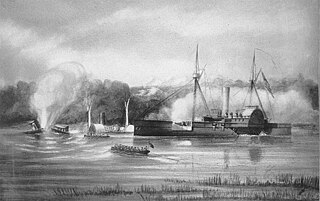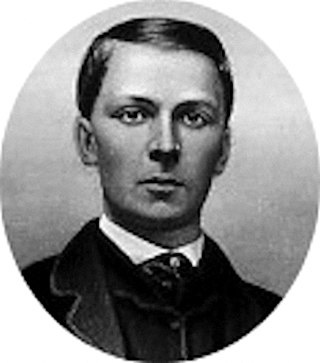Related Research Articles

CSS Albemarle was a steam-powered casemate ironclad ram of the Confederate Navy, named for an estuary in North Carolina which was named for General George Monck, the first Duke of Albemarle and one of the original Carolina Lords Proprietor.

William Barker Cushing was an officer in the United States Navy, best known for sinking the CSS Albemarle during a daring nighttime raid on 27 October 1864, for which he received the Thanks of Congress. Cushing was the younger brother of Medal of Honor recipient Alonzo Cushing. As a result, the Cushing family is the only family in American history to have a member buried at more than one of the United States Service Academies.

The second USS Metacomet was a wooden sidewheel steamer in the United States Navy during the American Civil War. The ship was named for Metacomet, a war chief of the Wampanoag Indians.

USS Tacony was a double-ended, side-wheel steamboat acquired by the Union Navy during the third year of the American Civil War. She was outfitted as a heavy gunboat with powerful guns and used in the Union blockade of the waterways of the Confederate States of America.

USS Wyalusing was a double-ended, side-wheel gunboat that served in the United States Navy during the American Civil War. She was named for the borough of Wyalusing in Bradford County, Pennsylvania.

USSWhitehead, a screw steamer built in 1861 at New Brunswick, New Jersey, served as a gunboat in the United States Navy during the American Civil War.
Alexander S. Crawford was a sailor in the United States Navy who served in the American Civil War. He received the Medal of Honor for his actions during the war.

USS Commodore Hull was a ferryboat acquired by the Union Navy during the American Civil War. She was outfitted as a gunboat and assigned to the Union blockade of the Confederate States of America.
John Lafferty or Laverty was a sailor in the U.S. Navy during the American Civil War and is one of only 19 people in history to receive the Medal of Honor twice.

Richard Hamilton, a Union Navy Coal Heaver, received the Medal of Honor for bravery for his participation in the sinking of the CSS Albemarle during the American Civil War.
USS Belle was a steamer acquired by the Union Navy during the American Civil War.

USS Bazely was a steamer acquired by the Union Navy during the American Civil War. She was used by the Union Navy in a tugboat/patrol boat role in support of the Union Navy blockade of Confederate waterways.
John W. Lloyd was a Coxswain in the Union Navy and a Medal of Honor recipient for his actions in the American Civil War.

Michael C. Horgan was a Union Navy sailor in the American Civil War who served under the alias Martin Howard. He received the United States military's highest decoration, the Medal of Honor, for his actions during the capture of Plymouth, North Carolina.
Daniel Noble (1838–1903) was a Confederate prisoner at Camp Douglas before becoming a Union Navy sailor in the American Civil War and a recipient of the U.S. military's highest decoration, the Medal of Honor, for his actions at the Battle of Mobile Bay.
Landsman Lorenzo Denning was an American soldier who fought in the American Civil War. Denning received the country's highest award for bravery during combat, the Medal of Honor, for his action aboard USN Picket Boat Number One on 27 October 1864. He was awarded the medal on 31 December 1864, but died before it was presented to him.

Daniel Griffin George alias William Smith was a Union Navy sailor in the American Civil War who received the U.S. military's highest decoration, the Medal of Honor.

Bernard Harley was an Ordinary Seaman in the Union Navy during the American Civil War, where he earned the Medal of Honor.

Edward J. Houghton was an American sailor who received a Medal of Honor for his actions in the American Civil War whilst serving in the U.S. Navy.

Robert Henry King was an American sailor and recipient of the Medal of Honor who earned the award for his actions during the American Civil War.
References
- ↑ "USN Ships--Picket Boat Number One". www.ibiblio.org. Retrieved 2021-05-28.
- ↑ "Henry Wilkes | U.S. Civil War | U.S. Navy | Medal of Honor Recipient". Congressional Medal of Honor Society. Retrieved 2021-05-28.
- ↑ II, Kenneth C. Crowe (2014-10-28). "Rensselaer honors Civil War hero". Times Union. Retrieved 2021-05-28.
- ↑ "Henry Wilkes - victoriacross". vconline.org.uk. Retrieved 2021-05-28.
- ↑ "Henry Wilkes | U.S. Civil War | U.S. Navy | Medal of Honor Recipient". Congressional Medal of Honor Society. Retrieved 2021-05-28.
- ↑ "Henry Wilkes - Recipient -". valor.militarytimes.com. Retrieved 2021-05-28.